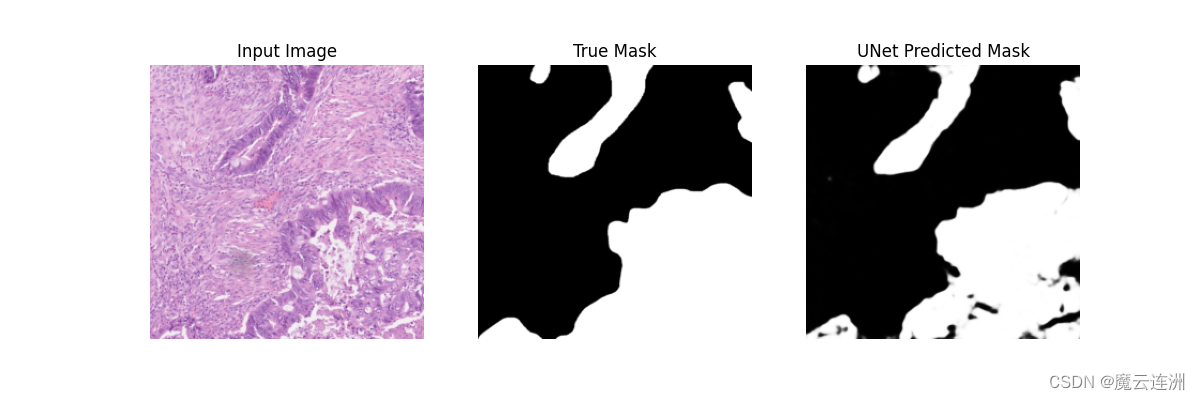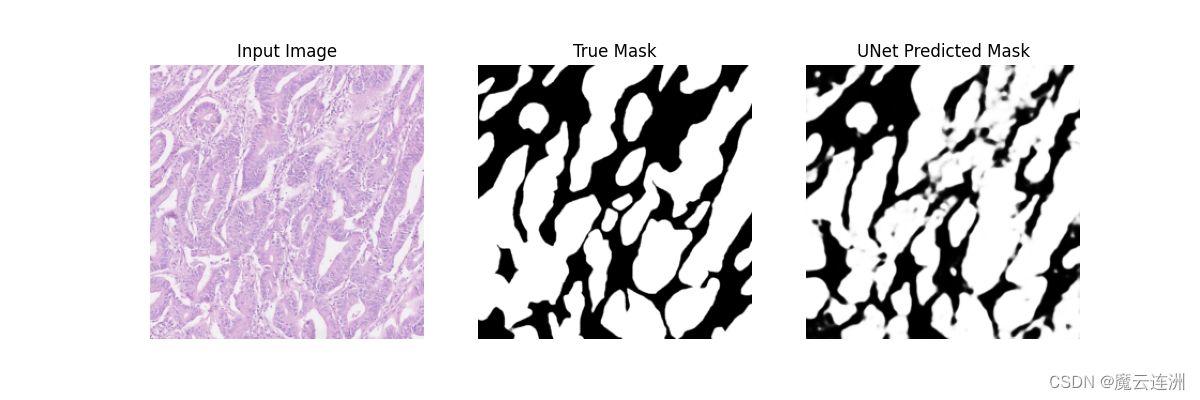数据集链接:https://pan.baidu.com/s/1IBe_P0AyHgZC39NqzOxZhA?pwd=nztc
提取码:nztc
-
UNet模型
import torch
import torch.nn as nnclass conv_block(nn.Module):
def init(self, ch_in, ch_out):
super(conv_block, self).init()
self.conv = nn.Sequential(
nn.Conv2d(ch_in, ch_out, kernel_size=3, stride=1, padding=1, bias=True),
nn.BatchNorm2d(ch_out),
nn.ReLU(inplace=True),
nn.Conv2d(ch_out, ch_out, kernel_size=3, stride=1, padding=1, bias=True),
nn.BatchNorm2d(ch_out),
nn.ReLU(inplace=True)
)
def forward(self, x):
x = self.conv(x)
return xclass up_conv(nn.Module):
def init(self, ch_in, ch_out):
super(up_conv, self).init()
self.up = nn.Sequential(
nn.Upsample(scale_factor=2),
nn.Conv2d(ch_in, ch_out, kernel_size=3, stride=1, padding=1, bias=True),
nn.BatchNorm2d(ch_out),
nn.ReLU(inplace=True)
)
def forward(self, x):
x = self.up(x)
return x
class UNet(nn.Module):
def init(self, img_ch=3, output_ch=1):
super(UNet, self).init()
self.Maxpool = nn.MaxPool2d(kernel_size=2, stride=2)
self.Conv1 = conv_block(ch_in=img_ch, ch_out=64)
self.Conv2 = conv_block(ch_in=64, ch_out=128)
self.Conv3 = conv_block(ch_in=128, ch_out=256)
self.Conv4 = conv_block(ch_in=256, ch_out=512)
self.Conv5 = conv_block(ch_in=512, ch_out=1024)
self.Up5 = up_conv(ch_in=1024, ch_out=512)
self.Up_conv5 = conv_block(ch_in=1024, ch_out=512)
self.Up4 = up_conv(ch_in=512, ch_out=256)
self.Up_conv4 = conv_block(ch_in=512, ch_out=256)
self.Up3 = up_conv(ch_in=256, ch_out=128)
self.Up_conv3 = conv_block(ch_in=256, ch_out=128)
self.Up2 = up_conv(ch_in=128, ch_out=64)
self.Up_conv2 = conv_block(ch_in=128, ch_out=64)
self.Conv_1x1 = nn.Conv2d(64, output_ch, kernel_size=1, stride=1, padding=0)def forward(self, x): # encoding path x1 = self.Conv1(x) x2 = self.Maxpool(x1) x2 = self.Conv2(x2) x3 = self.Maxpool(x2) x3 = self.Conv3(x3) x4 = self.Maxpool(x3) x4 = self.Conv4(x4) x5 = self.Maxpool(x4) x5 = self.Conv5(x5) # decoding + concat path d5 = self.Up5(x5) d5 = torch.cat((x4, d5), dim=1) d5 = self.Up_conv5(d5) d4 = self.Up4(d5) d4 = torch.cat((x3, d4), dim=1) d4 = self.Up_conv4(d4) d3 = self.Up3(d4) d3 = torch.cat((x2, d3), dim=1) d3 = self.Up_conv3(d3) d2 = self.Up2(d3) d2 = torch.cat((x1, d2), dim=1) d2 = self.Up_conv2(d2) d1 = self.Conv_1x1(d2) output = torch.sigmoid(d1) # 在最后加上Sigmoid激活函数 return output -
数据加载
import os
from PIL import Image
from torch.utils.data import Dataset
from torchvision import transformsclass SegmentationDataset(Dataset):
def init(self, image_dir, mask_dir, output_size=(256, 256)):
self.image_dir = image_dir
self.mask_dir = mask_dir
self.image_list = os.listdir(image_dir)
self.output_size = output_size
# 定义图像和掩码的变换
self.image_transform = transforms.Compose([
transforms.Resize(self.output_size),
transforms.ToTensor()
])
self.mask_transform = transforms.Compose([
transforms.Resize(self.output_size),
transforms.ToTensor()
])def __len__(self): return len(self.image_list) def __getitem__(self, idx): image_name = self.image_list[idx] image_path = os.path.join(self.image_dir, image_name) mask_path = os.path.join(self.mask_dir, image_name) image = Image.open(image_path).convert("RGB") # 确保是RGB mask = Image.open(mask_path).convert("L") # 确保是灰度图像 image = self.image_transform(image) mask = self.mask_transform(mask) return image, mask -
训练和测试。训练函数中保存的最好模型后缀最大(因为loss小才保存当前这个epoch的模型,我训练的最好模型是第171轮产生的),测试代码包含计算模型性能指标的代码和保存结果图片的代码。
import os
import numpy as np
import torch
import torch.optim as optim
from sklearn.metrics import confusion_matrix
from torch import nn
from torch.utils.data import DataLoader
import matplotlib.pyplot as plt
from tqdm import tqdm
from UNet import UNet
from DataLoader2 import SegmentationDatasetIoU计算
def compute_iou(pred_mask, true_mask):
smooth = 1e-6 # 避免分母为0
pred_mask = (pred_mask > 0.5).float()
true_mask = (true_mask > 0.5).float()intersection = (pred_mask * true_mask).sum() union = pred_mask.sum() + true_mask.sum() - intersection return (intersection + smooth) / (union + smooth)Dice系数计算
def compute_dice(pred_mask, true_mask):
smooth = 1e-6 # 避免分母为0
pred_mask = (pred_mask > 0.5).float()
true_mask = (true_mask > 0.5).float()intersection = (pred_mask * true_mask).sum() return (2. * intersection + smooth) / (pred_mask.sum() + true_mask.sum() + smooth)精度、召回率和F1分数计算
def compute_precision_recall_f1(pred_mask, true_mask):
pred_mask = (pred_mask > 0.5).numpy().astype(int)
true_mask = (true_mask > 0.5).numpy().astype(int)# 将mask平展为一维数组 pred_mask_flat = pred_mask.flatten() true_mask_flat = true_mask.flatten() conf_matrix = confusion_matrix(true_mask_flat, pred_mask_flat) tn, fp, fn, tp = conf_matrix.ravel() precision = tp / (tp + fp) recall = tp / (tp + fn) f1_score = 2 * (precision * recall) / (precision + recall) return precision, recall, f1_score训练函数
def train():
model = UNet()
dataset = SegmentationDataset('./dataset_exp2/train/image', './dataset_exp2/train/label')
dataloader = DataLoader(batch_size=16, shuffle=True, dataset=dataset)
# 训练参数
num_epochs = 200
learning_rate = 1e-4
# 损失函数和优化器
criterion = nn.BCELoss()
optimizer = optim.Adam(model.parameters(), lr=learning_rate)
# 设备
device = torch.device('cuda:3' if torch.cuda.is_available() else 'cpu')
model = model.to(device)
model.train()
best_loss = float('inf')
for epoch in range(num_epochs):
epoch_loss = 0
for images, labels in dataloader:
images = images.to(device)
labels = labels.to(device)
outputs = model(images)loss = criterion(outputs, labels) optimizer.zero_grad() loss.backward() optimizer.step() epoch_loss += loss.item() if epoch_loss < best_loss: best_loss = epoch_loss torch.save(model.state_dict(), f'./save_model_UNet/res_{epoch + 1}.pth') print(f'Epoch {epoch + 1}/{num_epochs}, Loss: {epoch_loss / len(dataloader)}')def test():
model = UNet()
# 确保模型在CPU上
model.load_state_dict(torch.load('./save_model_UNet/res_171.pth'))
save_dir = './test_results_UNet'
model.eval()
dataset = SegmentationDataset('./dataset_exp2/test/image', './dataset_exp2/test/label')
dataloader = DataLoader(batch_size=1, shuffle=False, dataset=dataset)
iou_list = []
dice_list = []
precision_list = []
recall_list = []
f1_list = []
plt.ion()
with torch.no_grad():
for idx, (images, labels) in tqdm(enumerate(dataloader)):
pre = model(images)
img_pre = torch.squeeze(pre)
img_true = torch.squeeze(labels)
iou = compute_iou(img_pre, img_true)
dice = compute_dice(img_pre, img_true)
precision, recall, f1_score = compute_precision_recall_f1(img_pre, img_true)
img_pre = img_pre.numpy()
img_true = img_true.numpy()
img_x = torch.squeeze(images).numpy().transpose(1, 2, 0)
img_x = (img_x * 255).astype(np.uint8) # 恢复到0-255的范围
# 保存结果
plt.figure(figsize=(12, 4))
plt.subplot(1, 3, 1)
plt.title('Input Image')
plt.imshow(img_x)
plt.axis('off')plt.subplot(1, 3, 2) plt.title('True Mask') plt.imshow(img_true, cmap='gray') plt.axis('off') plt.subplot(1, 3, 3) plt.title('UNet Predicted Mask') plt.imshow(img_pre, cmap='gray') plt.axis('off') plt.savefig(os.path.join(save_dir, f'result_{idx + 1}.png')) plt.close() # 关闭当前figure,避免内存占用过多 iou_list.append(iou.item()) dice_list.append(dice.item()) precision_list.append(precision) recall_list.append(recall) f1_list.append(f1_score) plt.ioff() # 关闭交互模式 print(f'Results saved in {save_dir}') print(f'Average IoU: {np.mean(iou_list)}') print(f'Average Dice Coefficient: {np.mean(dice_list)}') print(f'Average Precision: {np.mean(precision_list)}') print(f'Average Recall: {np.mean(recall_list)}') print(f'Average F1 Score: {np.mean(f1_list)}')if name == 'main':
print('++++++++++++++++train++++++++++++++++')
train()
print('++++++++++++++++test++++++++++++++++')
test()
测试效果:

